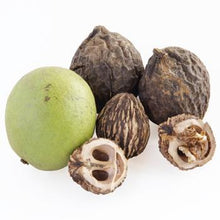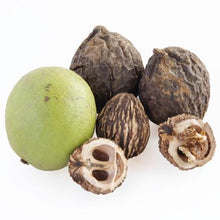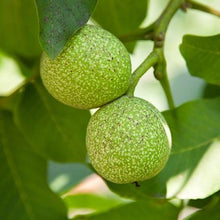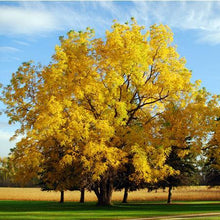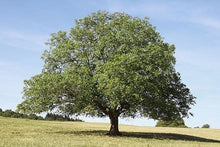
Classic Walnut Tree
Whether for Taste or Timber, Black Walnut Trees have it all
Can't decide between a tree known for its fine wood and a fruit bearing tree with a healthy harvest?
The Black Walnut will give you all that and more. A wide-branched tree reaching heights between 70 and 150 feet, the Black Walnut does well in open fields, on sloped land and a diversity of planting sites so long as the soil is well drained and nutrient dense.
The beautiful dark brown color of its bark makes black walnut wood the most sought after wood in the world. The tree's nickname, 'American Walnut' is no fluke. Our forefathers adorned their homes, crafted barns and built fences with wood made from the black walnut. The leaflets, as large as some trees leaves, are dwarfed by the leaves themselves, which can grow up to a mammoth two feet long. And let's not forget the nut.
The thick, black husk that gives the tree its name serves as ample protection for a round, savory fruit packed with flavor. The tree yields a nut so rich and delicious, it can be enjoyed right out of the shell, baked in deserts or crushed and topped on your favorite ice cream. With an abundant autumn harvest, a single tree can produce hundreds of nuts in just one season.
How to Keep your Black Walnut Healthy
The main thing to remember when caring for your Black Walnut tree is to keep weeds and grasses under control in the planting area because they will limit walnut growth. For quality wood production and to maximize walnut yields, use corrective and clear stem pruning methods. Fertilizer containing trace amounts of zinc aids in fruit growth and can be applied every other year. To help ensure branch health, don't pick nuts directly from the tree. Simply shake the branches up and down and enjoy a healthy shower of delicious nuts for many years to come.
Planting & Care
The Black Walnut tree (Juglans nigra) or “American Walnut” is a moderately growing, cold tolerant nut producing tree that is not only sought for it’s bountiful walnut harvest but also the dark, beautiful brown wood. They are commonly planted in USDA growing zones 4-9 which means they can not only take the cold but a good amount of heat as well. The Black Walnut tree will mature to a gargantuan height of 70-150 feet tall and as much as 30-40 feet wide so make sure there are no obstructions for the tree to grow such as power lines. This full sun loving, moderate grower produces an abundant harvest in the fall around September to October, simply shake the branches and be ready for a showering of delicious walnuts!
Seasonal Information: Generally it is best to plant your tree in the early fall, at least six weeks before the first frost in order to give the roots enough time to become established before winter sets in, or in the early spring six weeks after the final frost. However, you can plant your tree at any time of the year as long as your ground isn’t frozen. If you plant during the summer simply make sure that your trees get enough water to balance the heat.
Location: When deciding where to plant your walnut trees remember that they will perform best in full sunlight. Although, they can tolerate partial shade as long as they have at least six hours of direct sunlight a day. Avoid planting these nutty trees in an area of your yard that’s prone to flooding, or that collects standing water. Also, account for your tree’s massive size. Give it enough space from structures so it can reach its mature width, and don’t plant them under power lines.
Planting directions:
1) Once you have picked the perfect planting location dig a hole that’s just as deep as the root ball on your tree and three times as wide.
2) Take a pitch fork or shovel and scrape it along the sides of the hole to loosen the soil. Check for any debris like rocks, grass, or dirt clumps and remove them from the hole.
3) Next place your tree in the hole and make sure that it’s level with the surrounding ground and standing straight upwards at a 90 degree angle.
4) Slowly back fill the hole and gently tamp the soil down.
5) Once you’ve completed the planting process give your tree a long drink of water and mulch the area to conserve soil moisture.
Watering: We often find that plants are harmed more by over watering than under watering. Keep this in mind when it comes to watering your walnut tree. Allow the soil to dry out two inches below the surface before watering your trees. When it’s time to give your trees more water hold a hose to their bases and count to 30 seconds in order to give them a slow, deep watering.
Fertilization: In order to give your walnut trees a boost give them some well balanced fertilizer like formula 10-10-10 twice a year. Once in the early spring and again in the early fall. If your soil is lacking in nutrients you can fertilize up to once a month during the growing season. Always remember to wait until your tree has experienced one year of growth before fertilizing.
Weed Control: Prevent weeds from growing under the canopy by spreading 3 to 4 inch thick layer of mulch around the base. The mulch won’t allow weeds to grow, and it will also help your soil retain moisture. If you spot some weeds that need removing you can remove them by taking a firm grasp on them and pulling them upwards out of the ground in a twisting motion.
Pollination: Most Walnut varieties are self-fertile. They have both male and female flowers on a single tree. The female flowers open and wait for pollen to be spread from the male flowers, relying on natural pollinators like the wind and bees to make sure the pollen is spread from point A to point B. This being said pollination often has better chances if you have two or more trees for pollen to spread from.
Pruning: During the early spring is the best time of year to prune your walnut trees. You will want to prune any broken, damaged, or diseased branches. Also, remove any crisscrossing or rubbing branches. Make sure that your tree has sunlight and air flow through the canopy, this will allow the air and sunlight to knock out molds and fungi.
Be sure to look at your tree and plan where to make your cuts. Just like with a haircut, you can always remove more hair later, but if you cut too much it may take a while to grow back. Use a sharp and sterile pair of hand pruners or loppers and make your cuts at 45 degree angles facing upwards in order to promote new growth.




